General F-class photos

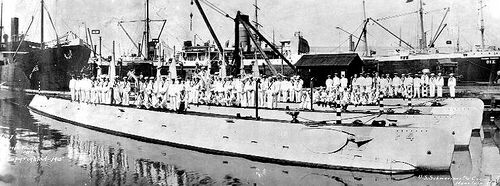
Photo in the private collection of Ric Hedman.
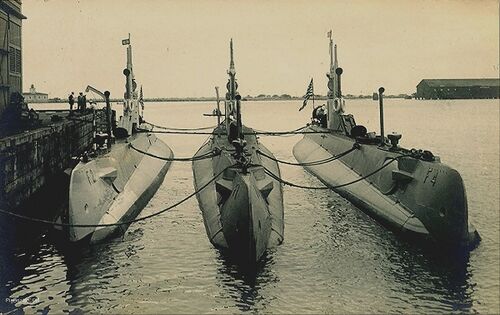
A very commonly reproduced photo of the USS F-2, F-1 and the ill-fated F-4 moored, most likely, at Pier 5A in Honolulu Harbor. The photo was between the arrival of the F-class submarines in Hawaii in the July of 1914 and the March 25, 1915 sinking of the F-4. The four F-boats were towed to Hawaii by the cruisers USS South Dakota (Armored Cruiser No. 9) and West Virginia (Armored Cruiser No. 5).
The flat land area seen in the background is Sand Island. The building/lighthouse seen on the left is marking the inner entrance channel to the harbor and is called the Honolulu Harbor Light Station. On the right the large building is the Quarantine Dock where ships from overseas were moored until cleared by the health inspectors. When the F-4 was finally raised after her sinking, her first stop was at these docks still hanging from chains under the lifting pontoons while a dry dock was made available.
Pearl Harbor at this time was mainly a coaling station for larger ships. The submarine base and shipyard wasn't ready until 1920 so the submarine fleet moored normally at Piers 5 & 5A near the entrance to Honolulu Harbor.
U.S. Navy photo.
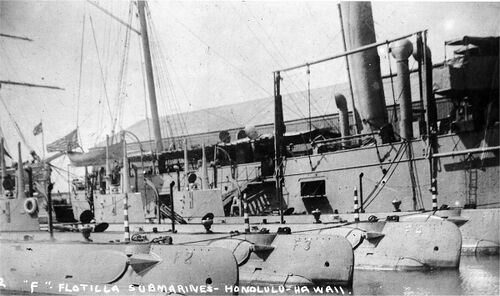
All four F-class submarines moored to the tender USS Alert (AS-4) in Honolulu Harbor, circa early 1915. The F-4 sank on March 25, 1915. This might be one of the last known F-4 photos prior to her loss with all hands. The Alert arrived in Hawaii in early 1915 in company with four K-class submarines.
The ship aft of the Alert is the German unprotected Cruiser SMS Geier that was being pursued by Japanese and British Navy ships and had taken shelter in the neutral port of Honolulu. Claiming engine problems, she needed repair parts from Germany which she couldn't get. She was more or less stranded there until the U.S. entered the war and seized the Geier, renaming her USS Schurz. She was placed into American service for the war effort.
Being a declared neutral port there were legal restrictions on what information could be reported, and the Germans and Japanese both claimed the U.S. had violated this when a radio station in Honolulu had reported the Geier's presence in Honolulu. The Navy censor had not been there at the time to monitor the report. This caused all sorts of international problems. As it turned out later the Geier's crew had broken the room radio room seals placed there by U.S. officials and had transmitted messages that caused legal battles even after WW I had ended.
Photo contributed by MMCM(SS) Rick Larson, USN (Ret.)
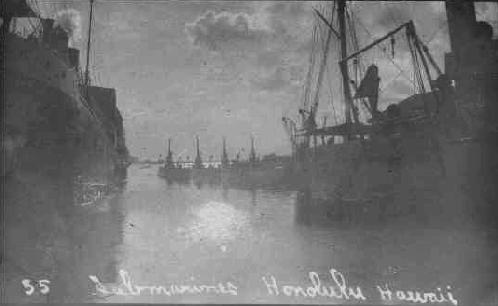
An unfortunately poor quality photo of the F-boats moored together at Honolulu in 1915. The photo looks to have been taken at nearly the same time as the one above, just from a different angle.
Photo in the private collection of Ric Hedman.
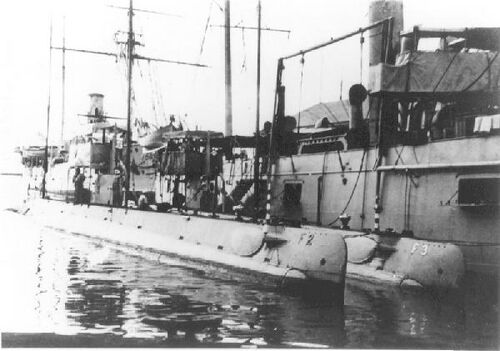
The USS F-2 and F-3 alongside the USS Alert, a submarine tender. The location is Honolulu Harbor circa 1915. The interned German cruise SMS Geier is moored in the background.
Photo in the private collection of Ric Hedman.
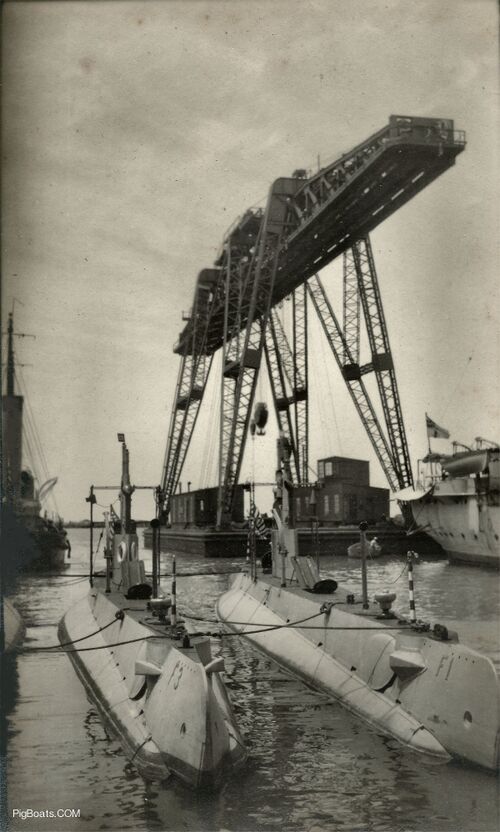
This wonderful photo comes to us from a contributor in the Netherlands. The photo shows the F-1 and the F-3 moored to what is probably Navy Pier 5. There is a third submarine at the far left but not enough is seen to know if this is the F-2 or the ill-fated F-4. With this unknown it is hard to date the photo though with the crane being so prominent it is a good guess to say it is most likely post March 25, 1915 and prior to November 1915 when the F-class were towed to the mainland.
The floating derrick YD-25 is seen in the background. Efforts to raise the F-4 first utilized this crane but the sunken boat proved too heavy.
Note the shape difference in the fairings over the bow plane mechanism. The F-1 and F-2 were built at Union Iron Works in San Francisco and the F-3 and F-4 were built in Seattle at the Moran Company yards. Just subtle differences in building styles.
Most interestingly is the ship moored at the far right in the photo. This is the interred German unprotected cruiser SMS Geier of the Bussard class. The Geier was in need of engine repairs and coal to fuel her boilers and put into the neutral United States port at Honolulu, Hawaii in October 1914. Unable to get the parts from Germany to repair the engines she remained at Honolulu where she was eventually interred.
After the American entrance into the war in April 1917, the U.S. Navy seized Geier, commissioned her as USS Schurz, and placed her on convoy duty. She was ultimately sunk following a collision with a freighter off the coast of North Carolina, with one man killed and twelve injured. She rests at a depth of 115 feet.
The Geier was armed with ten 4.1 inch guns, one of which can be seen just below and to the left of the lifeboat. The German Naval Ensign is flying from the stern. When the still submerged hulk of the F-4 was towed into the harbor the Geier, along with all the other ships in harbor, lowered her flag to half-mast in tribute.
Photo contributed by Erik van Gemst from The Netherlands.
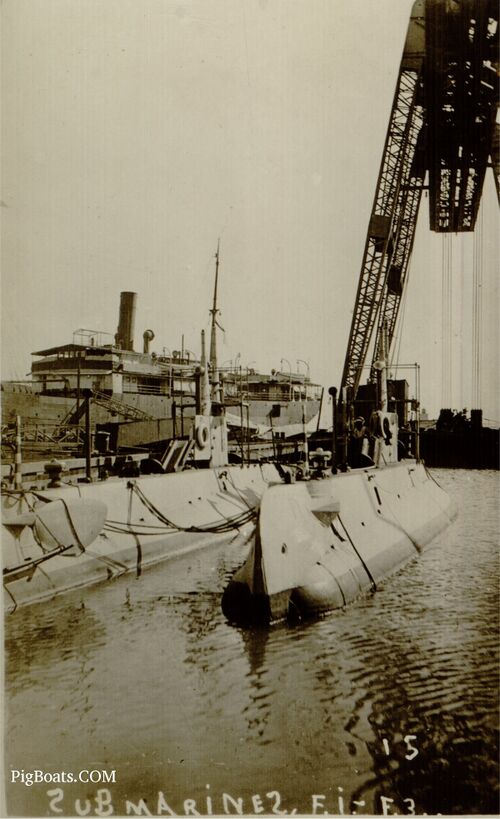
This interesting photo was most likely taken in late March or April of 1915, during the salvage operations for the F-4. The location is Honolulu Harbor, TH. The large derrick in the background is the Navy floating derrick YD-25. Normally employed for construction activities at the brand-new base under construction at Pearl Harbor, the crane had been moved to Honolulu to support the F-4 salvage. Unfortunately, the sub proved to be too heavy for the crane so lifting pontoons ultimately had to be used.
The two submarines in the foreground are (left to right, despite what the caption says) the F-3 and the F-1. Whether this photo was taken before or after the one above in unknown. There are at least several days between the two images. The location of the crane has moved slightly and there is a difference in the waterline levels of the two submarines. This photo is a little ironic in that just two years later, during night maneuvers off the coast of San Diego, these two boats would collide in the darkness, resulting in the loss of the F-1 and nineteen of her crew.
Seen just to the immediate right of the pipe frame for the F-1 bridge tarpaulins, peeking over the crane barge deck, is the cupola for the Honolulu Harbor Light House with the smaller lantern on its top. To the left side of the F-1 bridge fairwater is an F-1 sailor. He is seen standing behind the torpedo loading ramp.
The large ship in the left background is the German collier SS Locksun that was to supply coal to the German raider SMS Geier. They entered Honolulu several days apart and were not known immediately to be connected. When the U.S. entered WW I the ship and its valuable cargo of coal was seized and commissioned into the USN as the USS Gulfport. She was decommissioned and sold in 1922.
Note the confusion of the person hand printing, backwards, with white ink on the negative, trying to make the letters look correct.
Photo in the private collection of Ric Hedman.
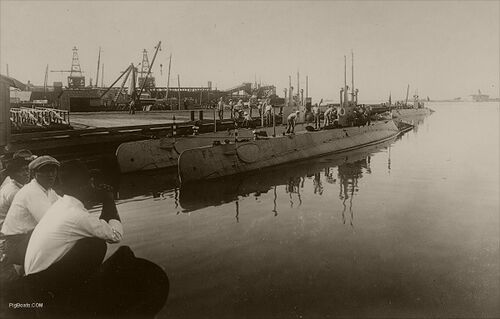
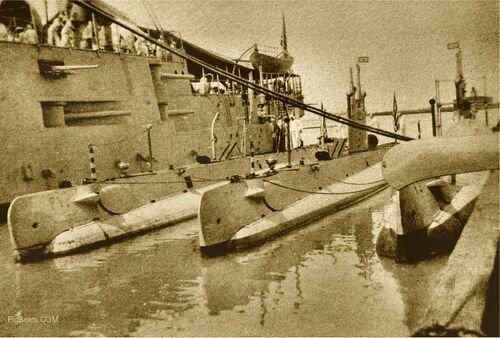

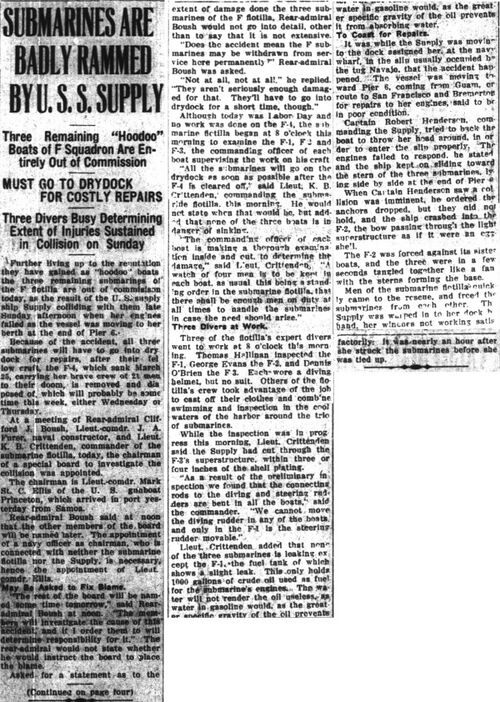
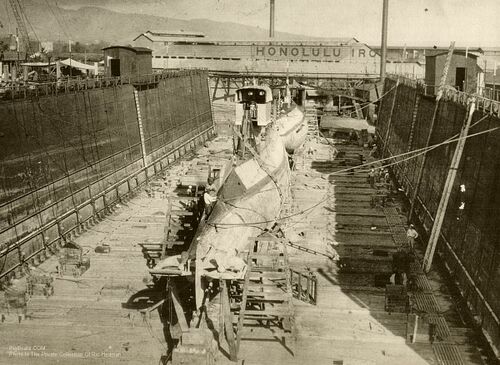
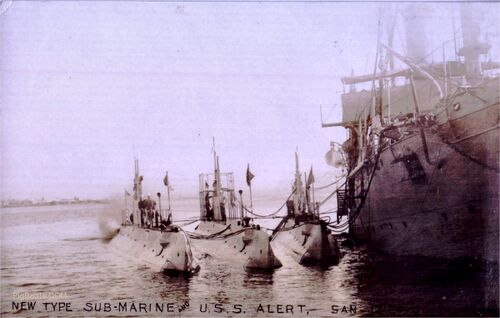
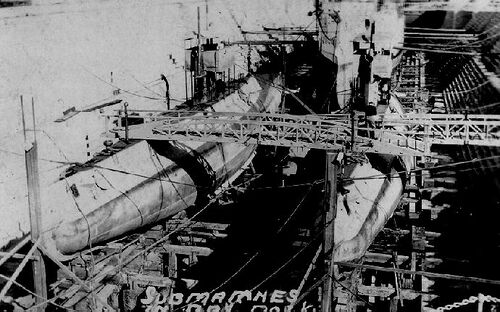
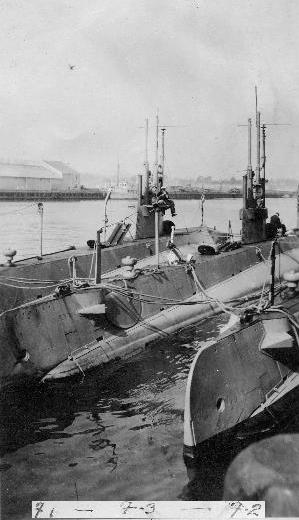
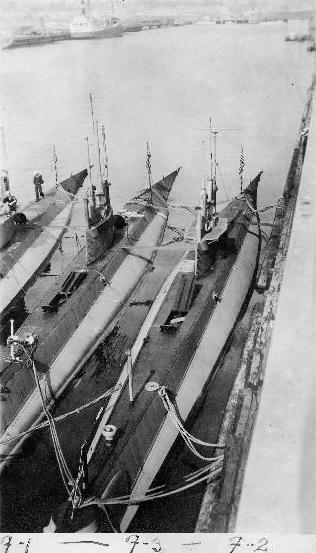
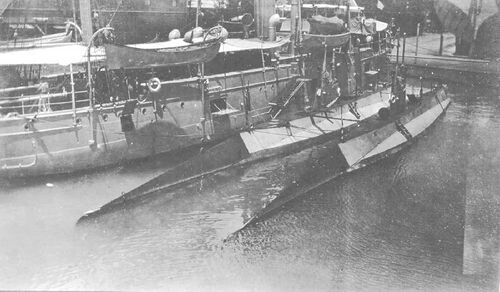
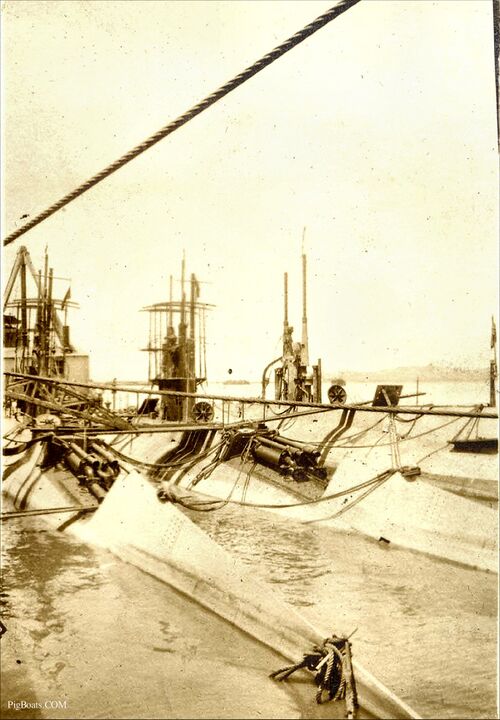
The right-hand submarine has had panels removed from both sides of its conning tower fairwater, exposing all the systems within it. She also has a deck plate propped up to access equipment within the superstructure.
The middle and left-hand submarines have had the superstructure removed over their engine mufflers and exhausts for some sort of maintenance.
Photo courtesy of Mike Dilley, whose father, Homer "Pat" Dilley sailed aboard the USS F-2.
Page created by:
Ric Hedman & David Johnston
1999 - 2023 - PigBoats.COM©
Mountlake Terrace, WA, Norfolk, VA
webmaster at pigboats dot com